[더프리뷰=서울] 편집자 = 지난 9월 22-24일 핀란드 헬싱키 댄스하우스에서 있었던 국립무용단 <회오리> 공연에 대한 Dansportalen의 리뷰를 번역, 게재한다. 1995년 창간된 Dansportalen은 스톡홀름, 예테보리, 헬싱키, 런던에 편집자가 있으며, 주로 스웨덴어로 발간되는 댄스 웹사이트이다.
필자: 아니타 요켈라(Anita Jokela)
원문에서 영문번역: 시모 바시넨(Simo Vassinen)
영문에서 한글번역: 김수인

<회오리>에서 테로 사리넨의 인상적인 안무와 악수하는 한국무용의 전통과 의례
테로 사리넨은 2014년부터 한국 국립무용단(NDCK)과 협력해왔다. 그때 무용단은 레퍼토리를 확장하려는 아이디어로 그에게 작업을 의뢰했다. <회오리>의 음악은 한국의 장영규가 전통 악기를 위해 작곡했다. 이 작품은 서로 다른 문화를 이해하기 위한 공동 노력의 정신으로 만들어졌으며, 한국 무용과 무용수들이 배운 기술을 기반으로 한다.
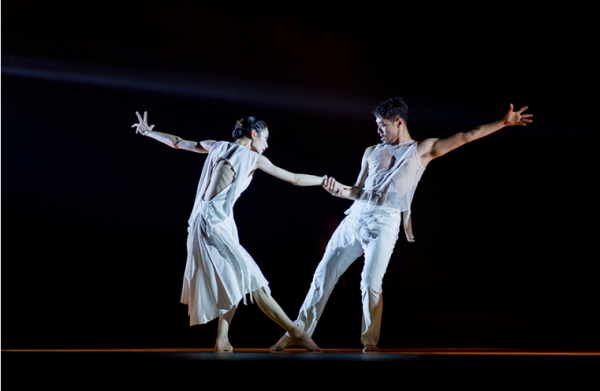
댄스하우스 헬싱키에 도착한 국립무용단은 많은 관심을 받았다. 모든 공연이 매진되었다.
한국무용은 그 기원이 깊으며 샤머니즘적 제의와 의례가 특징이다. 무용수들의 전체 기술은 몸통에서 시작하여 호흡에 따라 신체의 모든 부분으로 확장된다. 사리넨은 이를 최대한 활용했다. 안무의 큰 틀은 사리넨의 다른 작품과 마찬가지로 대규모 군무 장면에 있다. 이 모든 것은 우리가 보던 것과는 다른 동화 같은 풍경으로, 저항할 수 없을 정도로 아름다운 이벤트 배열로 펼쳐진다.

5명의 솔리스트 그룹과 14명의 군무로 구성된 무용수들은 4명의 연주자로 구성된 오케스트라와 합류하며, 그 중 한 명은 인상적인 보컬 솔리스트 역할도 한다. 이승희의 극도로 강한 보컬은 가사가 없다. 때때로 그녀는 무대 중앙으로 나와 장면의 초점이 된다. 연주자의 악기는 피리와 해금을 포함한 전통적인 악기이다.
무용수 송지영은 긴 등과 늘씬한 몸매가 돋보이는 블랙 의상을 입고 있으며, 솔리스트 황용천, 박혜지, 이석준, 송설은 각자의 흑백 의상을 입고 풍부한 표현력과 철저한 수행력을 보여준다.
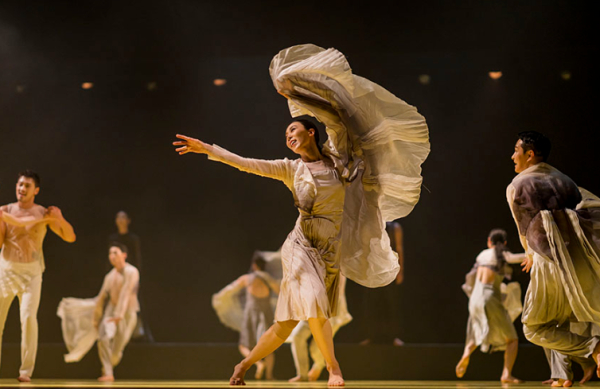
도전적인 안무는 파트너와 함께 균형을 잡는 리프트와 포즈를 특징으로 한다. 종종 남성이 여성의 발목을 잡고 몸과 반대 방향으로 움직인다. 군무 장면은 시각적으로 즐겁고 훌륭한 춤추기를 보여준다. 전체 캐스트가 모두 참여했다. 다양한 대형에서 무아지경에 빠진 듯한 군무가 자주 등장하며, 80분간의 공연이 쉴 새 없이 진행되는 내내 분위기가 짙어진다.
<회오리>는 세 부분으로 구성되어 있으며, 그 중 첫 번째 부분인 ‘조류(Tide)’는 우리를 이 세계로 데려가서 우리가 경험하게 될 것을 소개한다. 두 번째 부분인 ‘전파(Transmission)’는 콘텐츠의 경험을 심화시킨다. 세 번째이자 마지막 부분인 ‘회오리(Vortices)’의 흐름은 소리와 빛의 효과, 빠른 필사적 움직임이 있는 지옥 같은 장면으로 끝난다. 존재하는 모든 것을 끝내기 위해 생각할 수 있는 모든 것, 그리고 나서: 어둠, 고요.
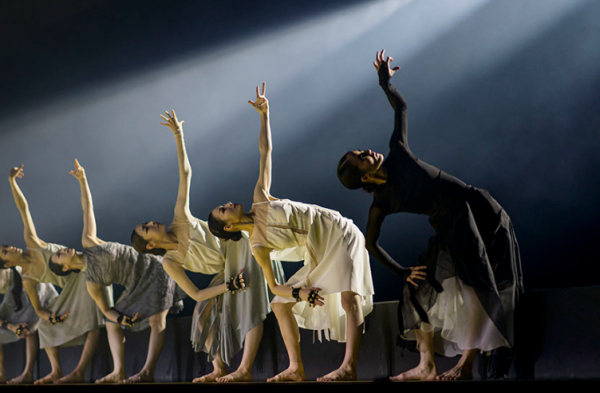
에리카 투루넨의 의상은 아름답고 단순하며 기능적이다. 미키 쿤투의 조명 디자인과 마찬가지로 솔리스트의 흐르는 베일이 안무의 일부로 사용된다. 공연이 시작되면 남자 솔리스트의 팔과 무대의 시야가 경쾌한 트릭으로 확장되어 순식간에 기이한 풍경을 연출한다.
사리넨 특유의 강렬함과 세심한 안무 솔루션을 따르는 이 공연은 절대적으로 볼 가치가 있다. 최고 수준의 국립무용단 초청 공연을 관람할 수 있는 좋은 기회이기도 했다. 이것은 테로 사리넨 무용단이 항상 포함하는 아티스트 토크를 듣기 위해 머물렀던 관객들에게 남겨진 느낌이기도 했다. (공연관람 일자 9월 23일)

솔리스트: 송지영, 황용천, 박혜지, 이석준. 이전 공연에서는 김미애(조안무 겸임)와 박기환.
군무 앙상블: 노문선, 이도윤, 박소영, 이태웅, 이요음, 최호종, 박지은, 박준명, 장윤나, 조승열, 김은이, 황태인, 정소연, 조용진.
연주자: 나원일(피리), 박순아(가야금), 이승희(소리), 천지윤(해금).
Established in 1995, Dansportalen is a (mainly) Swedish-language dance writing website with editors in Stockholm, Gothenburg, Helsinki and London.
DANSPORTALEN
27 September 2022
Original text:
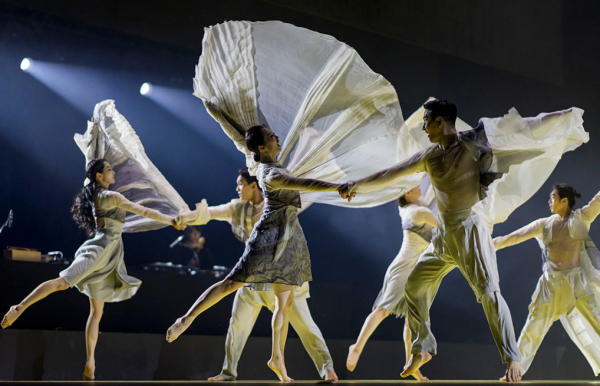
Korean dance traditions and rituals shake hands with Tero Saarinen's impressive choreography in Vortex
Tero Saarinen has collaborated with the National Dance Company of Korea (NDCK) since 2014. It was then that the company commissioned a work from him with the idea of expanding their repertoire. The music for Vortex was composed by South Korean Young-guy Jang for traditional instruments. The work was created in the spirit of a joint effort to understand the different cultures, and is based on Korean dance and the techniques learned by the dancers.
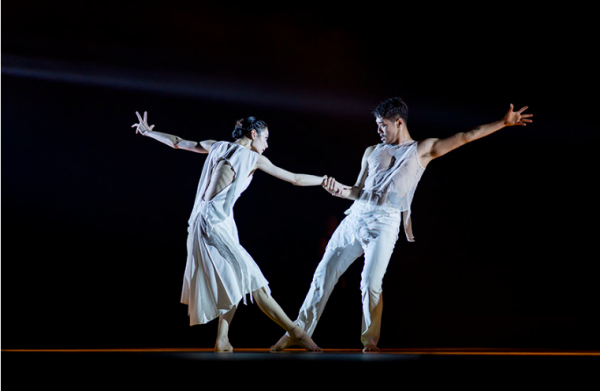
The group arrived at Dance House Helsinki to present their guest performance to great interest. All the performances were sold out.
Korean dance has its origins deep in history, and is characterised by shamanistic rites and rituals. The whole technique of the dancers starts in the torso and expands according to the breath to all parts of the body, and Saarinen has taken full advantage of this. The template of the choreography is in large group scenes, like in some of Saarinen's other works, and all this unfolds in an irresistibly beautiful array of events, a fairytale landscape that is different to what we are used to seeing.
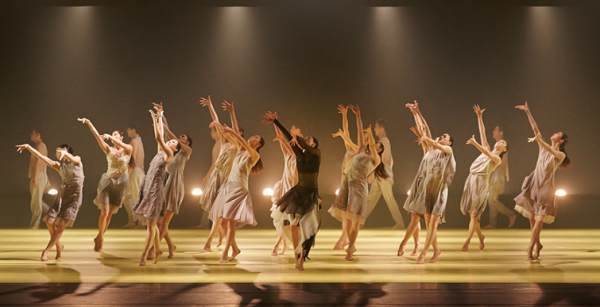
The dancers, a group of five soloists and a corps of 14, are joined by an orchestra of four musicians, one of whom also serves as an impressive vocal soloist. Seunghee Lee's extremely strong vocals feature no words. At times she becomes the focal point in the centre of the stage. The musicians' instruments are traditional ones; a flute and string instruments.
The dancer Ji-young Song is clad in a black costume that beautifully highlights her long back and slender figure, and the other soloists Youngcheon Hwang, Hae-jee Park, Seogjun Lee, and Sul Song in their individual black and white creations, are expressive and thorough in their tasks.
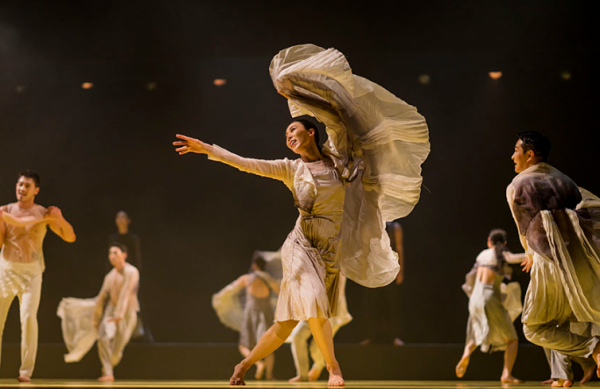
The challenging choreography features lifts and poses that play with balancing with the partner –– often so that a man grabs a woman’s ankle and moves in the opposite direction with his body. The group scenes are visually pleasing and well danced. The entire cast is fully engaged. They often appear as if in a trance in the various formations, and the atmosphere becomes dense throughout the 80-minute performance without a break.
Vortex consists of three parts, the first of which, Tide, serves to take us into this world, introducing what we are about to step into. The second part, Transmission, deepens the experience of the content. The flow in Vortices, the third and final part ends in a, let's say, hellish scene with sound and light effects, and fast desperate movements –– everything you can think of to create an end to everything in existence, and then: darkness, silence.

The costumes by Erika Turunen are beautiful, simple, and functional. The soloists’ flowing veils are used as part of the choreography, as is the lighting design by Mikki Kunttu. At the beginning of the performance, the arms of the male dance soloist and the views of the stage are extended with light tricks, which immediately creates a peculiar landscape.
This performance, following the intensity and careful choreographic solutions typical to Saarinen, was absolutely worth seeing. It was also a great opportunity to witness a guest performance by the top-class National Dance Company of Korea. This was also the feeling left in the audience who stayed to hear the artist talk, a concept always included by the Tero Saarinen Company.
Anita Jokela
Helsinki
Tero Saarinen
Vortex, Dance House Helsinki, 23 September

Solo dancers: Ji-Young Song, Youngcheong Hwang, Hae-jee Park, Seogjun Lee. In previous performance Mi-ea Kim (also the choreographer's assistant) and Kihwan Park. Ensemble: Moon-sun Noh, Soon-youn Lee, Sooyoung Park, Tae-woong Lee, Yoeum Lee, Hojong Choi, Ji-eun Park, Joonmyun Park, Yun-na Jang, Seungyeol Cho, Euni Kim, Taein Hwang, So-young Jung, Yongjin Cho. Musicians – the Korean instruments in brackets: Wonil Na (piri), Soona Park (gayageum), Seunghee Lee (sori), and Jiyoon Chun (haegeum).
(Translation into English by Simo Vassinen)

